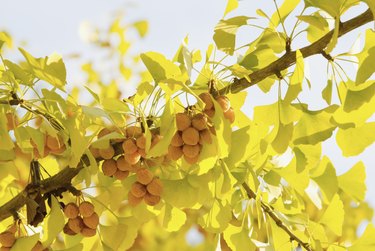
Adding golden yellow color to fall landscapes with its fan-shaped leaves, the ginkgo or maidenhair tree (Ginkgo biloba) reaches 50 to 75 feet tall. Suited to U.S. Department of Agriculture plant hardiness zones 3a through 8a, they're slow growing at first, tolerating many soil types as long as there's good drainage. Trees are either male or female, with only females producing seed-bearing fruits. Because fruits are messy and smell bad, landscaping trees are usually propagated from male trees by grafting or rooting cuttings. You can grow ginkgo from seeds, but you can't tell if they will be male or female. Seeds need treatment for good germination, are slow to sprout and won't be exact clones of the parent.
Gathering Seed
Video of the Day
When starting with fresh ginkgo fruits, either pick them off the tree or collect them from the ground in late fall through early winter. The flesh contains rancid-smelling compounds that can damage your skin, as well as urushiol, the same chemical found in poison ivy, which can cause an allergic skin reaction. Whenever handling fruit or undried seeds, wear long, waterproof gloves, protective clothing and protective eyewear. If you're sensitive to breathing the compounds, also wear a respirator.
Video of the Day
Cleaning Seed
To soften the flesh for easier removal, put the fruits in a plastic bucket of water with some dish-washing soap added. After several days to a week, stir and squeeze the mixture, pouring off the liquid outside in a grassy or native soil area where it won't be contacted by people or pets or spread into water. Add fresh water and repeat until the flesh is all washed away and the seeds are clean and well-rinsed. If a seed floats, discard it. Spread seeds out in a single layer in the sun to air-dry.
Pretreating Seed
Ginkgo seeds need two maturation periods to germinate well. After the fruits form, the seeds need an after-ripening period of one to two months for the embryo to develop, which usually happens by early to mid-fall. This happens naturally if you don't collect the seeds until mid-fall. Then cold-treat the clean, dry seeds, putting them between moist paper towels in a plastic bag and keeping them in the refrigerator crisper drawer for two months. Check occasionally for mold formation and moisture levels, replacing moldy paper towels with fresh ones and keeping the toweling moist but not soggy.
Germinating and Planting
For germinating cold-treated seeds, fill a nursery flat that has drainage holes with a soilless mix that contains perlite or vermiculite to within 2 inches of the top edge. Sow seeds 2 inches apart in the flat, covering seeds with about 1 inch of mix. After watering until water comes through the drainage holes, place in a sunny window or greenhouse and keep the mix moist but not soggy. Sprouting is usually 15 to 40 days after sowing, but some seeds take a long time to germinate and some seeds don't sprout.
In cold winter areas, you can also germinate cleaned seed outdoors, where nature takes care of the cold treatment. Sow fresh seeds right after they're cleaned in a cold frame or sheltered outdoor bed with well-draining soil and keep the soil moist.
Caring for Seedlings
When seedlings in the flat or in the cold frame or outdoor bed have several sets of true leaves and the roots are holding the soil mass together, transplant each seedling to an individual 6-inch pot filled with the same potting mix used for germination. Place the 6-inch pots from either indoor or outdoor germination sites outdoors. Put them in partial shade and grow them through the summer and fall, moving the pots either into a greenhouse or cold frame before freezing weather occurs. Grow them through the winter.
Transplanting Seedlings
When the last freezing weather is over the next spring, transplant the 1-year-old seedlings into their garden location. Choose a site with full sun. Usually grown as a specimen plant, ginkgo seedlings need a space 50 to 60 feet wide to accommodate mature growth. Slow-growing ginkgos don't need much fertilizer. Apply a general purpose fertilizer such as 8-8-8 in spring before new leaves emerge. Evenly scatter fertilizer over the soil surface around the tree at the rate of 1 pound per 100 square feet.
- University of Florida IFAS Extension: Ginkgo Biloba: Maidenhair Tree
- University of Georgia: Warnell School of Forest Resources: Ginkgo Seed Collection & Preparation
- U.S. Forest Service: Ginkgo Biloba L.
- Monrovia: Autumn Gold Maidenhair Tree
- Mississippi State University Extension Service: Fertilizing Ornamental Trees & Shrubs
- Plants for a Future: Ginkgo Biloba - L.